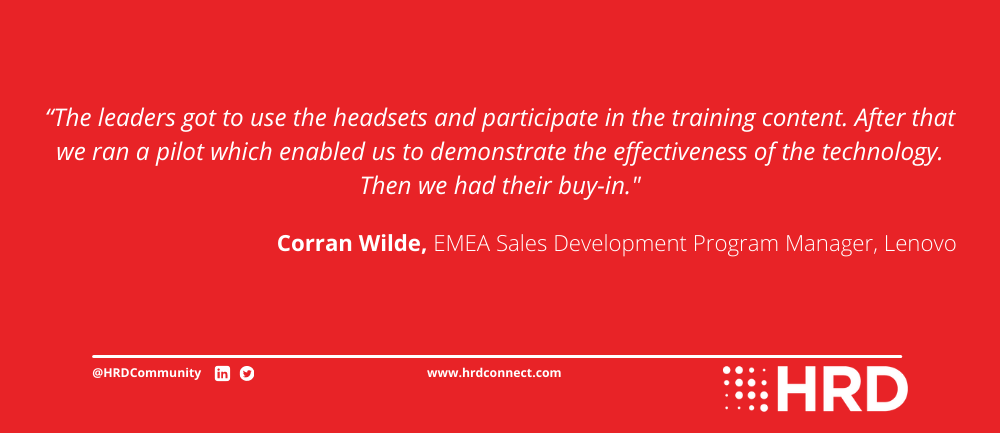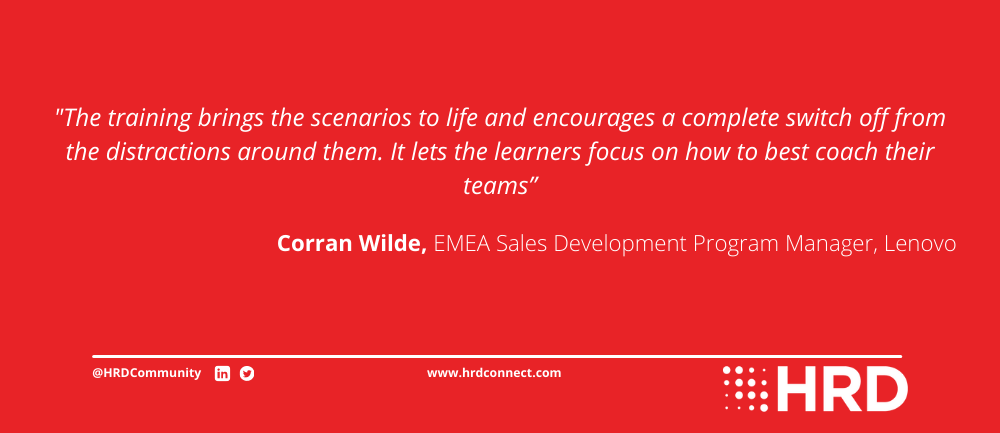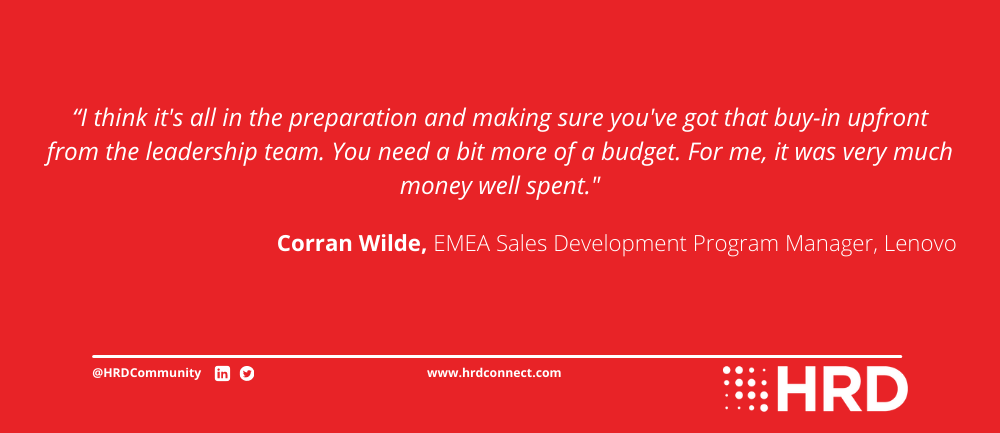-
Provided by

- Date published: May 9, 2023
- Categories
Necessity is the mother of invention. During a period of change management at Lenovo, the learning team seized the opportunity to reinvigorate sales training for its sales leaders, a historically tough group to pin down. Packed diaries often mean securing training time can be tricky. However, creating an interesting proposition that involved using Lenovo’s own Virtual Reality headsets combined with a bespoke immersive training program has pushed engagement to the max, and set in motion a new era of L&D.
“We are approaching some of our salespeople with different propositions and wanted to help support them from the top down, adjust their behaviors, and help them better understand how their people are feeling,” explains Corran Wilde, EMEA Sales Development Program Manager at Lenovo who looks after the development of the company’s managers and salespeople.
Wilde wanted an application that would focus primarily on sales performance and the interaction of the Lenovo salespeople. This included upskilling in softer skills, such as communication, and improving the team’s approach to each other. She also wanted to create something that could help onboard new employees, coach leaders, and update the quality and safety standards in the workforce. The use of new technology would also hopefully boost engagement. Lastly, there was a long term goal for the technology to be scalable across multiple international locations.

Creating the dream team
Wilde and Joe Cleary, Solution Consultant at Lenovo, worked closely with Lenovo’s own Think Reality team that supplied the VR headsets. Together, this team worked closely with Client Relationship Manager Shirley Densham, and James Barton, Chief Technology Officer, both from Mentor Group, and creative software development company, Uptale, to design a platform and bring it to life. The aim was to create real-life scenarios using VR to deliver training and maximize the learning experience.
The concept of VR in training is slowly gaining traction. But for the uninitiated, Wilde explains how it functions.
“Lenovo manufactures the headsets, but you’ve got to have something to put on them. It’s like you’ve bought your television, but you need to sign up to Netflix or Skype or have a BBC license to access the content. In terms of digital enablement, virtual delivery seemed at the beginning of the pandemic. Now we don’t think twice about something like this.”
It took Lenovo and its team eight months to pull the concept together. Creating, designing, and scripting a bespoke program helped tailor the virtual learning experience to the scenarios Lenovo’s sales team typically experiences. Lenovo sales staff recorded on-site videos that added authenticity to the final product.

Getting buy-in
As the team required the help of the senior leaders to create the content for the training, securing interest and buy-in was less of a challenge and more of a formality. Moreover, this senior leadership involvement in putting together case scenarios was a useful endorsement for the initiative.
That said, Wilde points out some initial resistance as people tried to understand the concept and how it would be beneficial to the company. “We had some pushback because people couldn’t quite work it all out until we showed them exactly how it was going to progress.”
The team collaborated in a joint approach to overcome the obstacles and translate the benefits to the leaders. Wilde believes it was this networking element of the project that was particularly instrumental in getting the green light.
“There were a lot of setups and organization. That comes with a cost. It also meant that we were having to influence our leaders to show them that bringing people together and putting them into sales scenarios is an engaging and effective way to learn.
“The leaders got to use the headsets and participate in the training content. After that we ran a pilot which enabled us to demonstrate the effectiveness of the technology. Then we had their buy-in.”

Engagement and motivation: VR training isn’t one size fits all
This was a brand-new concept for the sales team to get their head around, quite literally. But the involvement of sales leaders and managers in co-creation helped soothe the skeptics. “Having their colleagues involved in the training brings the scenarios to life and encourages a complete switch off from the distractions around them. It lets the learners focus on how to best coach their teams,” explains Densham.
The program features a range of scenarios for different audiences, from managers and sales associates to customer service representatives. Each unit explores fundamental coaching methodologies, including ‘red herrings’ to deliver a real challenge and ensure focus throughout the program.
As all the training is delivered in person, attendees still receive familiar face-to-face interaction and guidance throughout the VR experience. This includes how to adjust to the immersive environment VR creates. It is limited to small groups of around 12, promoting knowledge sharing amongst participants and the opportunity for more thorough debriefs, post-training progress updates, and coaching follow-ups.
Early positive feedback
The response has been overwhelmingly positive: “We’ve had people asking us when the next one is and if they can get on the program. We haven’t come across any negativity really. Also, it’s not just a one-day event. It has far wider applications,” says Wilde.
Using this type of approach means the training is inclusive of all different learner types at Lenovo, be it digitally savvy users or those who are not typically comfortable with using the technology.
“We always want to bring new and innovative ways of learning to Lenovo. But we need to do it in a measured approach. If they don’t want to put a headset on, they can do complete training without it,” adds Wilde.
Follow-up support and training embed the knowledge for both groups and individuals. This approach has cascaded learning across the teams. “The content itself is about how to empower the managers. Obviously, that’s reached a wider group of people because the managers talk to their salespeople and share the learning using the same language that they’ve been taught,” adds Wilde.

Measuring the impact of VR on Lenovo’s L&D
While L&D metrics are not the easiest to capture, immersive VR training has had a notable impact on learners with a 38.30% increase in confidence after the program. Lenovo found the virtual training course had an average impact of 8.5 out of 10 on job role success.
Following the successful pilot in the UK in late 2022, Lenovo has rolled the program out across several Lenovo Hubs in EMEA. It has scheduled more training across the company’s European region for 2023, including Germany and the Nordics. It’s safe to say that this is now part of the Lenovo learning mix, despite challenges such as regional limitations and licensing considerations.
VR: The future of training?
This unique blend of virtual and real is signaling the way of things to come at Lenovo. But while it is not a huge leap for a tech innovator, are other sectors and businesses likely to have such a smooth ride in implementing VR into their training?
“I think it’s all in the preparation and making sure you’ve got that buy-in upfront from the leadership team. You need a bit more of a budget. For me, it was very much money well spent. VR enabled us to get to the detail quickly because it broke down those barriers,” reflects Wilde.
Since the success of VR learning, Lenovo is exploring alternative technologies that can help it take an inclusive approach to L&D.
“We are always looking at developing new learning modalities. We need to move with the times and make sure that we’re diverse in our approach. I think that’s important culturally speaking because working in Europe, the Middle East, and Africa people learn in different ways. This is one area that we really can move forward with,” she concludes.








